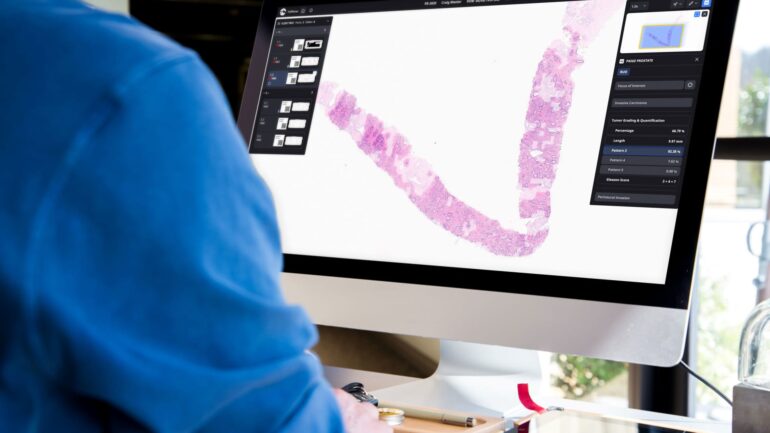TL;DR:
- Microsoft and Paige partner to create the world’s largest AI model for cancer detection.
- The AI model, trained on billions of images, aims to identify both common and rare cancers.
- Paige’s digital solutions and Microsoft’s infrastructure drive this pioneering project.
- Paige’s FDA-approved FullFocus tool enhances pathologists’ workflow, and AI aids in cancer identification.
- The digitization of pathology faces challenges in cost and data storage.
- The partnership between Paige and Microsoft could democratize healthcare access.
- A groundbreaking paper on their AI model is set to impact cancer care significantly.
Main AI News:
In a groundbreaking collaboration, Microsoft and Paige are poised to revolutionize the field of cancer diagnosis by constructing the world’s most extensive AI model for cancer detection. The ambitious project was officially unveiled by Microsoft on Thursday, marking a significant milestone in the realm of medical technology.
Harnessing the power of artificial intelligence, this pioneering AI model is being trained on an unprecedented volume of data, encompassing billions of medical images. Its capabilities extend beyond identifying common cancers to tackling the formidable challenge of diagnosing rare and elusive cancer types. With an acute awareness of the current strain on healthcare resources due to staffing shortages and surging caseloads, researchers are optimistic that this monumental endeavor will provide much-needed support to medical professionals.
Paige, a trailblazer in the realm of digital pathology and AI-driven solutions for pathologists, is spearheading this transformative initiative. Pathologists, the unsung heroes of medicine, play a pivotal role in determining a patient’s healthcare journey. As Thomas Fuchs, co-founder and chief scientist at Paige, aptly puts it, “You don’t have cancer until the pathologist says so. That’s the critical step in the whole medical edifice.”
Despite their indispensable role, the workflow of pathologists has remained largely unchanged for over a century. Traditionally, pathologists rely on microscopic examination of tissue samples on glass slides to detect cancer. While this method has proven effective, any oversight can have devastating consequences for patients. Paige has taken it upon itself to digitize and enhance the pathologists’ workflow to elevate accuracy and efficiency within this crucial medical specialty.
One of Paige’s notable achievements is securing approval from the Food and Drug Administration (FDA) for its FullFocus viewing tool. This innovation enables pathologists to examine digital slides on a screen, eliminating the need for traditional microscopes. Moreover, Paige has developed an AI model that aids pathologists in identifying breast cancer, colon cancer, and prostate cancer when displayed on the screen.
Nonetheless, the digitization of pathology presents its own set of challenges, primarily in terms of costs and data storage. Digitizing a single slide can demand substantial storage resources, posing financial barriers for smaller healthcare institutions. Historically, it has been affluent academic centers that could afford to invest in digital pathology, leaving smaller entities at a disadvantage.
Paige, originating from the prestigious Memorial Sloan Kettering Cancer Center in New York in 2017, possesses an extensive repository of data, which has been instrumental in its journey. To amplify their efforts and expand their AI’s cancer detection capabilities, Paige sought the partnership of tech giant Microsoft. Over the past year and a half, Paige has harnessed Microsoft’s cloud storage and supercomputing infrastructure to construct a cutting-edge AI model.
The scale of this collaboration is nothing short of remarkable. Paige’s original AI model relied on over a billion images from 500,000 pathology slides. However, the AI model developed in partnership with Microsoft is an astounding leap forward in scale. It is currently being trained on a staggering four million slides, aiming to identify both common and elusive cancer types. Paige boldly claims that it is the largest publicly announced computer vision model to date.
As Andy Moye, CEO of Paige, aptly states, “This is sort of a groundbreaking, land-on-the-moon kind of moment for cancer care.” He envisions a future where predictive modeling will provide pathologists and patients with readily accessible information about their biomarkers and genomic mutations.
Desney Tan, vice president and managing director of Microsoft Health Futures, emphasizes that Microsoft’s infrastructure is a linchpin of this partnership. Simultaneously, Microsoft is actively engaged in developing new algorithms, detection techniques, and diagnostics that align with Paige’s vision. Tan underscores that AI should be viewed as a tool that enhances pathologists’ capabilities, not as a replacement for their expertise.
In a significant development, Paige and Microsoft are set to publish a paper on their model through Cornell University’s prestigious preprint server, arXiv. The paper quantifies the model’s impact compared to existing solutions and underscores its superiority. This marks the first step in a long journey, as Paige aims to make its research available to the broader scientific community during the peer-review process. Subsequent steps include submission to the esteemed scientific journal Nature, followed by rigorous testing and collaboration with regulatory bodies to ensure safety and accuracy.
In the grand scheme of healthcare, the AI model heralds a transformative era. It not only addresses the storage conundrum faced by health systems but also accelerates the diagnostic process for pathologists, potentially reducing the waiting period for patients from weeks to days. As Thomas Fuchs articulates, “That really helps to democratize access to health care in these places,” particularly in community clinics where pathologists are inundated with an overwhelming number of cases across diverse cancer types.
Conclusion:
The partnership between Microsoft and Paige represents a significant leap in the healthcare market. Their AI model, trained on an immense dataset, has the potential to streamline cancer diagnosis and make it more accessible. This innovation not only addresses critical healthcare challenges but also opens up new possibilities for AI-powered solutions in the medical field. It signifies a promising future for improved patient care and diagnostic efficiency, with broader implications for the AI-driven healthcare market.

